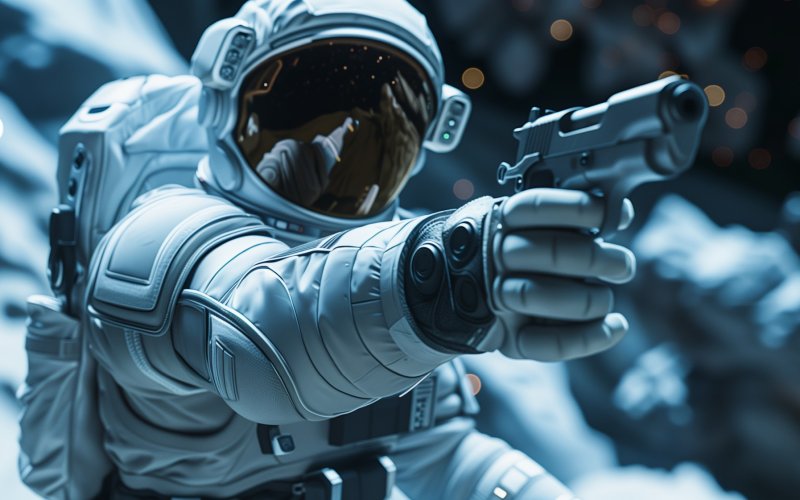So far, outer space in the solar system is a peaceful place where no one is shooting at anyone, but we can feel free to entertain hypotheticals about what if we needed to. Maybe that astronaut doesn’t want to shoot another astronaut, but a creepy alien monster.
If the heroic astronaut is near Earth and the monster is near Jupiter, then there is a distance of at least 628,814,140 kilometres between them. That’s if Jupiter is in opposition. If it is in conjunction, the distance between them will lie as far as 928 million kilometers. In such a situation, the Sun will also be between them, through which it will be extremely difficult to shoot.
Even in the event of Jupiter’s closest approach to Earth, the astronaut will face a daunting task. At a distance of over 600 million kilometres, hitting a target just a few metres across. Targeting something so tiny seems impossible, but it's not completely unfeasible. The Voyager 2 probe, for example, aims its antenna at the Earth more than 20 billion kilometres away. Space probes can land on distant asteroids just a few kilometres across. Although the monster at Jupiter will be completely invisible to the naked eye, it could be locked onto with modern technology.
Now the astronaut must choose a weapon. In the movies it is very often a laser gun that shoots coherent beams of light. Light propagates in space in a straight line. There’s no atmosphere to cause it to scatter or bend because of different densities. Its trajectory may be slightly affected by the sun’s gravity, but its effect will be minimal and can be easily calculated. The Earth or Jupiter are bodies so small that their gravitational effects on the light beam can be safely neglected. So if an astronaut aims well, a laser beam from his blaster can hit the monster by Jupiter.
The question is whether the monster will notice.
In a real laser beam, the photons do not fly parallel to each other, but it is a Gaussian beam. Which means its cross section changes over time and the beam diverges.
During the measurement of the distance between the Earth and the Moon, a laser beam three and a half metres in diameter was fired at a mirror left by the astronauts on the Moon. When it hit the Moon, it was two kilometres in diameter. Shooting all the way to Jupiter, the initially extremely thin and lethal beam would have stretched for many tens of kilometres. And because the energy density of the laser beam decreases as its cross-section expands, the originally deadly beam becomes completely harmless.
A brave astronaut can try to shoot the monster with an ordinary gun. When the trigger is pulled, the gunpowder charge ignites in the cartridge. Modern cartridges also contain an oxidizer so the cartridge is not dependent on the surrounding atmosphere and can be fired underwater. Or in a vacuum. The rapid development of gases will expel the bullet from the cartridge and give it a velocity of around 400 metres per second.
The projectile won’t get very far on Earth. The friction of the atmosphere and the effects of gravity will soon force it down the ballistic curve to the ground. In space, however, there is no atmosphere and no gravity, so the bullet is not slowed down and continues to fly at an undiminished speed. It reaches Jupiter with almost the same speed as it left the barrel of the gun.
The accuracy of the aiming could be affected by the gravitational field of the planets, the solar wind that will be leaning on the bullet, and because it is metallic, it might even experience a weak influence of the solar magnetic field. If the astronaut is a skilled physicist, he can calculate all this and point the projectile accurately.
There is one more inconvenience awaiting the astronaut when firing from Earth orbit. The bullet will probably be too slow to overcome the escape velocity from the grip of Earth’s gravity, which is 11,000 meters per second from low orbit. The bullet will either fall to the planet or, at the right speed, stay in orbit. With a truly unfortunate combination of direction and velocity, an astronaut could even shoot himself in the back!
If he shoots from the interplanetary environment, out of the gravitational reach of large bodies, he does not have to worry about the speed of his projectile. He could even fire a bow or a slingshot. Even these primitive weapons will work reliably in space. Only he must not hesitate to use them, because prolonged exposure to freezing temperatures and ultraviolet radiation would cause the sling rubber or bowstring to disintegrate.
Of course, the astronaut will have to include in his calculations a prediction of where his enemy will be in the distant future, because the slower the missile, the longer it will take to cross hundreds of millions of kilometres of the cosmic void. Even that gun bullet will take almost two years to reach Jupiter. But in theory, it really is possible to shoot across the solar system.
Want to ask something?
Send us an e-mail with the subject “Physics mysteries” to the address:
We can't wait to tackle your interesting questions!





